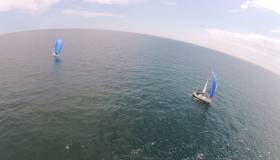Displaying items by tag: soloFastnet
SoloFastnet Fleet Picks Up The Pace In Celtic Sea
#soloFastnet - After a frustrating first 36 hours, the majority of the soloFastnet fleet have now passed Land’s End — with the lead solo sailors already halfway across the Celtic Sea towards Fastnet Rock.
All three classes got away from Cowes on Saturday afternoon (2 June) in bright sunshine and a 15-knot southwesterly, but that wasn’t to last as a wind drop and a turn of the tide saw most of the 28 competitors going in circles overnight.
There was some drama at the start when a cruiser heading towards the shore wandered into the middle of the Class 2 start line.
Meanwhile, Richard Clarke with his Sunfast 3200 Fury was unfortunate to T-bone a folk boat. Clarke continued racing but it soon emerged that the collision had cracked the bow structure, causing a leak into the crash box area, forcing his retirement after 140 miles sailed.
Sunday morning (3 June) saw the breeze pick up for some, with Stephane Bodin’s Wasabi Enertek making the best of the conditions among the more southerly boats, flying at double the speed (6kts) of their more northerly competitors.
Offshore certainly paid off by Sunday evening with those boats flying downwind in up to 25 knots, but more challenging seas — as shared by the Royal Western Yacht Club of England’s Round Britain & Ireland fleet.
As of 10am this morning (Monday 4 June), the lead is held by Ari Kansakoski’s Class 40 Fuji, with French entry Raging Bee 2 in hot pursuit.
There’s also been one more retirement from the fleet, at Matt Smith’s Full Circle headed to Plymouth after issues with a line joining floats in the water.
The soloFastnet race tracker and leaderboard can be found HERE.





























































